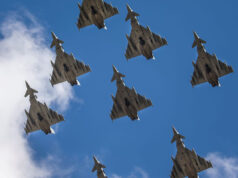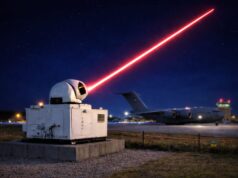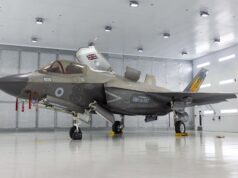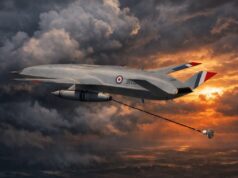The Protector unmanned aircraft, also known as ‘Certifiable Predator B’ has successfully undertaken its first flight in the United States.
General Atomics modified the Reaper platform into the so-called ‘certifiable Predator B’ in order to make it compliant with European flight regulations to get more sales by European countries. In order to fly over national airspace, the aircraft meets NATO STANAG 4671 airworthiness requirements with lightning protection, different composite materials, and sense and avoid technology; performance changes include a 24m wingspan that has winglets and enough fuel for a 40-hour endurance at 50,000ft.
The current Protector unmanned aircraft order is 16 with options for an additional 10.
According to a submission to the United States Defense Security Cooperation Agency, notifying congress of a foreign military sale:
“The State Department has made a determination approving a possible Foreign Military Sale to the United Kingdom for Certifiable Predator B Remotely Piloted Aircraft, equipment, training, and support. The estimated cost is $1.0 billion.
The Defense Security Cooperation Agency delivered the required certification notifying Congress of this possible sale on November 16, 2016.
The United Kingdom (UK) requested a possible sale of up to twenty-six (26) Certifiable Predator B Remotely Piloted Aircraft (16 with option for additional 10); twelve (12) Advanced Ground Control Stations (GCSs) (8 with option for additional 4); four (4) New Launch and Recovery Element GCSs; four (4) Upgrades to existing Blk 15 Launch and Recovery Element GCSs (2 with option for additional 2); twenty-five (25) Multi-spectral Targeting Systems (12 + 2 spares, with option for additional 10 + 1 spare); twenty-five (25) AN/APY-8 Lynx IIe Block 20A Synthetic Aperture Radar and Ground Moving Target Indicators (SAR/GMTI) (12+ 2 spares, with option for additional 10 + 1 spare); Eighty-six (86) Embedded Global Positioning System/Inertial Guidance Units (EGIs) (3 per aircraft) (48 + 5 spares, with option for additional 30 + 3 spares). This sale also includes communications equipment, Identification Friend or Foe (IFF) equipment; weapons installation kits; TPE331-10YGD engines; unique and common spares package; support equipment; U.S. Air Force technical orders; country specific technical orders; Contractor Logistics Support for two (optional three) years; contractor provided aircraft components, spares, and accessories; personnel training; and other related elements of logistical and program support. The total estimated program cost is $1.0 billion.
The UK is a close ally and an important partner on critical foreign policy and defence issues. The proposed sale will enhance U.S. foreign policy and national security objectives by enhancing the UK’s capabilities to provide national defence and contribute to NATO and coalition operations.
This sale will improve the UK’s ability to meet current and future threats by providing improved Intelligence, Surveillance and Reconnaissance (ISR) coverage that enhances homeland security, promotes increased battlefield situational awareness, augments combat search and rescue, and provides ground troop support. The Certifiable Predator B will also be used to support the UK’s armed forces and coalition forces engaged in current and future peacekeeping, peace-enforcing, counter-insurgent, and counterterrorism operations. The UK already operates armed remotely piloted aircraft, the MQ-9 Reaper, and will have no difficulty transitioning to the Certifiable Predator B.”
General Atomics modified the Reaper platform into the certifiable Predator B in order to make it compliant with European flight regulations to get more sales by European countries. In order to fly over national airspace, the aircraft meets airworthiness requirements with lightning protection, different composite materials, and sense and avoid technology.
According to the 2015 Strategic Defence and Security Review, the Royal Air Force will operate at least 20 Protector systems by 2025, replacing all of its current 10 MQ-9 Reapers.
According to a justification for a ‘sole-source award notification’ published on the 24th of April, the MoD has given General Atomics a GBP415 million (USD605 million) contract for the UAV. While the award did not disclose numbers, the UK government has previously said 20 will be procured.
According to the MoD:
“The Unmanned Air Systems Team of the UK Ministry of Defence intends to acquire the Protector unmanned aerial system through a government-government Foreign Military Sales contract with the US Department of Defense (DoD).
The MoD has conducted a thorough Assessment Phase that has concluded that the CPB is the only system capable of achieving UK Military Type Certification and delivering the Protector requirement within the required timescales. The only means of acquiring the CPB is through a contract with the US DoD”
In February, General Atomics announced that the long-endurance Predator B, which will eventually increase the flight time of the Reaper from 27h to 40h, had carried out its first flight. The aircraft is also expected to have a much greater payload than Reaper.
And an aerial picture from chase plane of the first flight of the RAF’s #Protector (CPB) by GA-ASI, taken on 17 Nov. pic.twitter.com/qR3VpBa22o
— COM(Air) DE&S (@Chf_Eng_Air) November 30, 2016
In 2016, the United Kingdom announced that it intended to place an order for the Certifiable Predator B as part of its Protector MALE UAV programme. According to the 2015 Strategic Defence and Security Review, the Royal Air Force will operate at least 20 Protector systems by 2025, replacing all of its current 10 MQ-9 Reapers.
RAF’s #Protector (Certifiable Predator B): smooth landing on second test flight @GA_AS_UK experimental Gray Butte airfield in Mojave desert pic.twitter.com/hUksg5yIAR
— COM(Air) DE&S (@Chf_Eng_Air) November 30, 2016
The RAF is the lead customer for Certifiable Predator B.













16 Protector UAV’s + 10 Optional, leads me to conclude we’ll probably end up with 16… Mind you, the MOD occasionally, maybe rarely throws in a surprise with order numbers like with the retained original procurement figure for the F-35B’s…
In the SDSR2015 they stated 20 UAV’s, it’s kind of strange they went for 16 with 10 optional, rather than 20 with 6 optional. I suspect we will end up with less than 16, or have a few of the 6 in storage.
I can imagine that the additional 10 may well be optimised for maritime patrol.
If they can get them communicating with the sonar boys and the p8’s, it would be a great way to increase coverage / endurance.